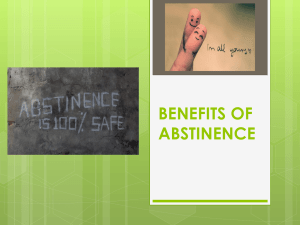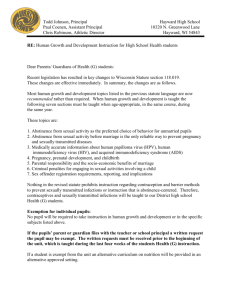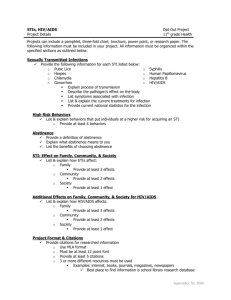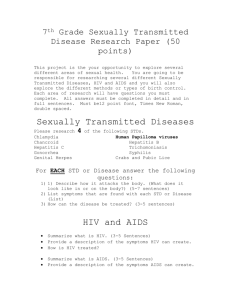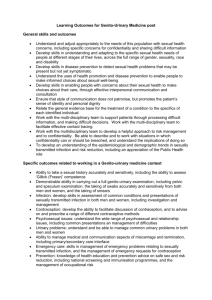• www.njsafehaven.org/ • http://www.pressofatlanticcity.com/
advertisement
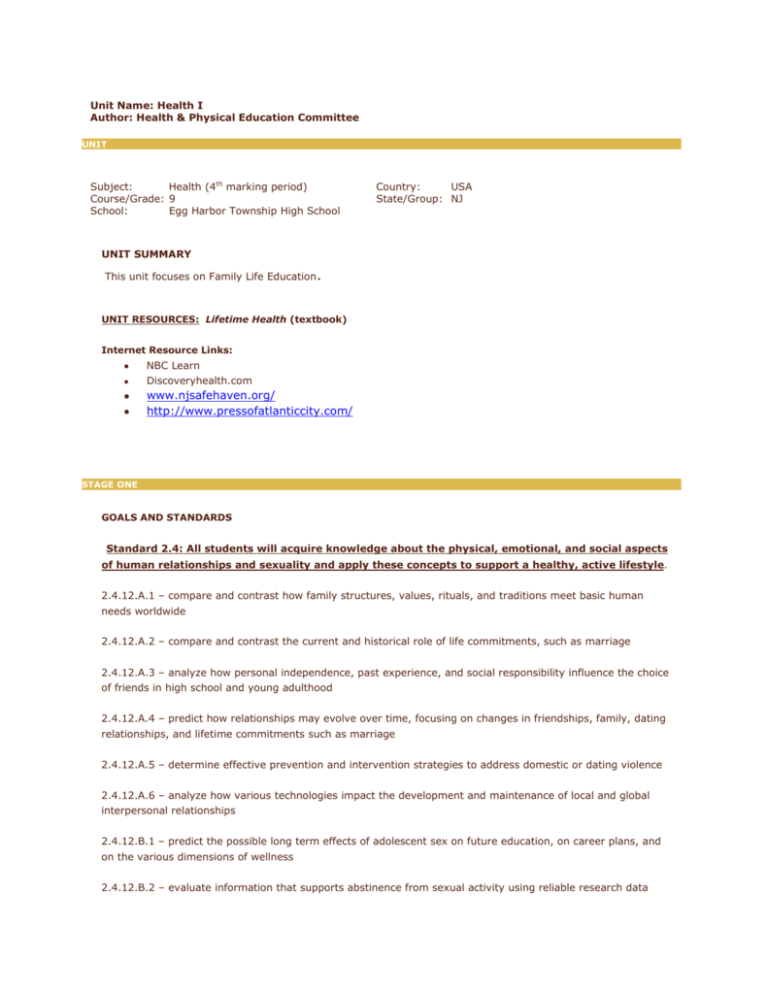
Unit Name: Health I Author: Health & Physical Education Committee UNIT Subject: Health (4th marking period) Course/Grade: 9 Egg Harbor Township High School School: Country: USA State/Group: NJ UNIT SUMMARY This unit focuses on Family Life Education. UNIT RESOURCES: Lifetime Health (textbook) Internet Resource Links: • NBC Learn • Discoveryhealth.com • • www.njsafehaven.org/ http://www.pressofatlanticcity.com/ STAGE ONE GOALS AND STANDARDS Standard 2.4: All students will acquire knowledge about the physical, emotional, and social aspects of human relationships and sexuality and apply these concepts to support a healthy, active lifestyle. 2.4.12.A.1 – compare and contrast how family structures, values, rituals, and traditions meet basic human needs worldwide 2.4.12.A.2 – compare and contrast the current and historical role of life commitments, such as marriage 2.4.12.A.3 – analyze how personal independence, past experience, and social responsibility influence the choice of friends in high school and young adulthood 2.4.12.A.4 – predict how relationships may evolve over time, focusing on changes in friendships, family, dating relationships, and lifetime commitments such as marriage 2.4.12.A.5 – determine effective prevention and intervention strategies to address domestic or dating violence 2.4.12.A.6 – analyze how various technologies impact the development and maintenance of local and global interpersonal relationships 2.4.12.B.1 – predict the possible long term effects of adolescent sex on future education, on career plans, and on the various dimensions of wellness 2.4.12.B.2 – evaluate information that supports abstinence from sexual activity using reliable research data 2.4.12.B.3 – analyze factors that influence the choice, use, and effectiveness of contraception, including riskreduction and risk-elimination strategies 2.4.12.B.4 – compare and contrast attitudes and beliefs about gender identity, sexual orientation, and gender equity across cultures 2.4.12.B.5 – relate preventative healthcare strategies of male/female reproductive systems to the prevention and treatment of disease (e.g. breast/testicular exams, Pap smear, HPV vaccine) 2.4.12.C.1 – compare embryonic growth and fetal development in a single and multiple pregnancies, including the incidence of complications and infant mortality 2.4.12.C.2 – analyze the relationship of an individual’s lifestyle choices during pregnancy and the incidence of fetal alcohol syndrome, sudden infant death syndrome, low birth weight, premature birth, and other disabilities 2.4.12.C.3 – evaluate the methods and resources available to confirm pregnancy 2.4.12.C.4 – determine the impact of physical, social, emotional, cultural, religious, ethical, and legal issues on elective pregnancy termination 2.4.12.C.5 – evaluate parenting strategies used at various stages of child development based on valid sources of information 2.4.12.C.6 – compare the legal rights and responsibilities of adolescents with those of adults regarding pregnancy, abortion, and parenting 2.4.12.C.7 – analyze factors that affect the decision to become a parent ENDURING UNDERSTANDINGS The Egg Harbor Township High School Family Life Education program is a component of the comprehensive Health Education Curriculum. The Family Life Education curriculum was developed in conjunction with the High School teachers of this course, parent and community input. Guidelines from the New Jersey State Department of Education, the Core Content Curriculum Standards and a review of several curriculum guides were included in developing this curriculum. This curriculum takes place during an entire marking period which consists of fortyfive (45) days. Parents are provided an outline of this Family Life Curriculum at Back-to-School night in the fall of the school year. It is also noted in the “Program of Studies” course selection book that parents can review the Family Life Curriculum at any time. This can be done by contacting the Supervisor of Health & Physical Education. If parents have conflicts with this curriculum due to religious or personal reasons, the parent needs to contact the Supervisor so that he/she can determine an appropriate alternate curriculum. The textbook for this course is LifeTime Health published by Holt, Rinehart,Winston: Copyright2009. • Relationships are the connections people have with each other. The Family provides the first opportunity for a person to develop relationship skills. Every family is different, but all families provide the foundation for future relationships. As individuals mature, they seek out different relationships with peers, colleagues, and loved ones. Through social networking, people even establish relationships with individuals they have never met. We now live in a world where families and relationships are constantly changing and where global communication systems have extended friendships and relationships across the miles. ESSENTIAL QUESTIONS • How does your family influence the adult you will become? • How do you develop and sustain relationships over time? • Why is it hard to have healthy relationships? KNOWLEDGE AND SKILLS • • • • • • • • • • • • • • • • • • • • • • • • • • • • • • • • • • • • • • • • Describe how puberty affects the male and female body; Describe the nonphysical changes that occur during adolescence; Learn how to use “I” messages instead of “You” messages; Learn active listening skills; Learn a methods of verbally resisting pressure; Learn a method of resolving conflict; Describe how to make and keep a friend; Name 3 functions that dating serves; Name 3 actions you can take that will help you cope with a breakup; Describe the difference between sexual and emotional intimacy; Name 3 possible consequences of teenage pregnancy; Describe the advantages of sexual abstinence; Consider how a pregnancy now would affect one’s life goals; Learn how to resist internal & external pressure to become sexually intimate; Apply the decision making model to decisions about one’s own sexual behavior; Name the major organs of the male & female reproductive system; Explain the 2 functions of the testes; Trace the path of the sperm from the testes to the outside of the body; Trace the path of the egg from the ovary to the uterus; Describe how the sperm meets in the egg and fertilizes it; Describe how to perform a testicular & breast self exam; Explain how the uterus changes during the menstrual cycle. List the substances that can pass from the mother to the placenta; Describe the events that occur during birth; Use self talk about childhood experiences to increase ones self esteem; Know the motto and mission of the Safe Haven Law; Name 2 places that people can drop off their unwanted newborn baby; Realize the implications of abandoning or murdering a newborn; Know the 3 stages of adulthood; Define emotional maturity; Name 3 concerns an elderly person might have; Know the difference between Alzheimer’s and Parkinson’s Disease; Name 2 reasons why people get married; Name 3 difficulties teenagers who marry encounter; Name 3 responsibilities of parenthood; Understand the actions and effectiveness of birth control contraceptives; Name the 3 main functions of healthy families; Name the characteristics of healthy families; Explain how families have changed in recent years; Consider what your own family will be like when you are an adult; • • • • • • • • • • • • • • • • • • Define the term sexually transmitted disease/infection; Know the names of common sexually transmitted diseases/infections; Know how sexually transmitted diseases are spread from one person to another; Know the signs and symptoms of sexually transmitted diseases; Know what you can do to decrease your chances of getting a Sexually Transmitted Disease/Infection; Name 10 ways one can show love for someone without sexual intimacy; Know where to go for testing and treatment for Sexually Transmitted Disease/Infections; Define AIDS & HIV; Describe how HIV works in the body; Describe the three phases of HIV; Find out where to get an HIV antibody test; Name the body fluids that may contain enough HIV to infect another person; List behaviors that put one at risk for HIV infection; Name behaviors that don’t put one at risk for HIV infection; Discuss abstinence as the most effective way to prevent the sexual transmission of HIV infection; Practice resisting pressure to be sexually intimate; Describe medical treatments available for HIV infection; Name actions one can take to help people with HIV infection STAGE TWO PERFORMANCE TASKS • Projects • Lecture/notes • Current events • Quizzes/tests • Journals • Oral presentations • Group debates OTHER EVIDENCE • Quarterly exam • Homework/class work assignments • Class activities • Formative/summative assessments STAGE THREE LEARNING ACTIVITIES I. Introduction (1 day) A. Sexuality – Abstinence B. Family Life Ground Rules II. Puberty: Male and Female (6 days) A. Changes during adolescence B. Communicating effectively 1. Active listening 2. Conflict Resolution C. Relationships/Dating D. Sexuality, Responsibility and Abstinence 1. Risks 2. Resisting Pressures III. Male Reproductive System (3 days) A. Structure and function 1. Terminology 2. Diagram B. Path of the Sperm IV. Female Reproductive System (5 days) A. Structure and function 1. Terminology 2. Diagram B. Path of the egg 1. Menstrual Cycle V. Pregnancy & Conception (6 days) A. Prenatal Development B. Prenatal Care of mother C. Delivery VI. Marriage and Parenthood (7 days) A. Successful marriages B. Reasons for marriage C. Teen Marriage D. Parenthood E. Contraceptives F. Safe Haven Law VII. Understanding Family Relationships (3 days) VIII. Sexually Transmitted Diseases/Infections and Abstinence (5 days) A. History B. Causes and Symptoms C. Treatment D. Abstinence and prevention IX. HIV/AIDS and Abstinence (6 days) A. Cause and symptoms B. Treatment C. Abstinence and prevention
